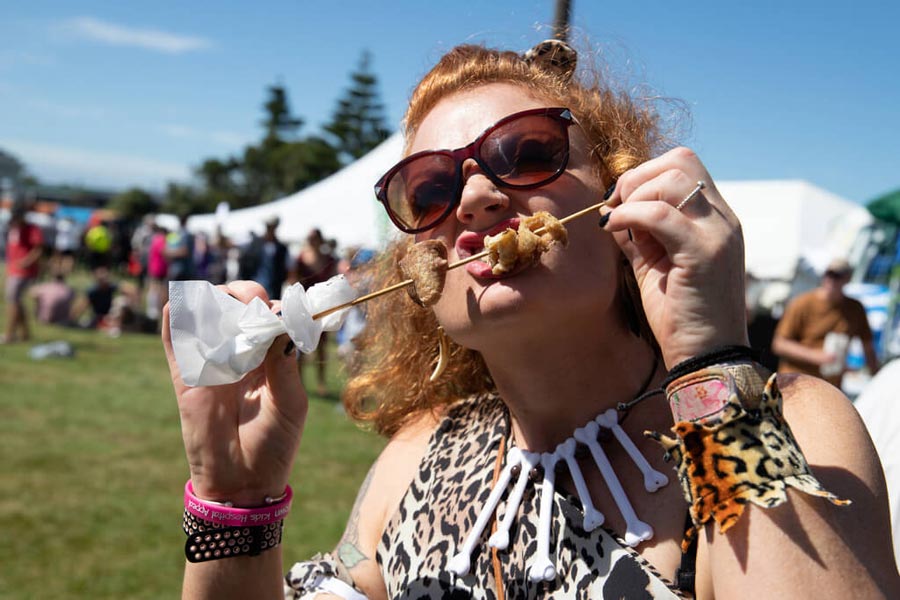Sliding, swimming, clambering, crawling … pull on a padded wetsuit, steel-capped gumboots and a helmet with a headlight, and there’s nothing you can’t do.
Come on, when else do you get the chance to slither through mud, in the dark, on your hands and knees or float on your back in the blackness of an underwater lake lit by a thousand glow-worms shimmering overhead? The day started like any other, but I’m about to have my world rocked by a black-water rafting adventure in New Zealand’s Waitomo Caves.
It’s a beautiful spring afternoon in the Waikato and I’m driving south to Waitomo Village and my TumuTumu TOObing expedition with Waitomo Adventures. A great day for heading underground, as our caving guide, Allan, points out a short while later. It’s another short drive, this time in a minivan with a couple of other intrepid cavers, from the Waitomo Adventure Centre to the cave site. As we drive, Allan describes the labyrinth that lies beneath the Waitomo Valley.
At our destination, a tranquil green valley dotted with native forest and disturbed only by the bleating of sheep, it’s hard to imagine the adventure that awaits underground. But we squeeze into our wetsuits and pull on our gumboots and try out the headlights on our helmets nonetheless. From here it’s a short walk along the valley and finally we’re confronted with the reality of what we’ve come here to do. Half hidden amongst the ferns, there’s a small gap between the rocks and an iron ladder descending into the chasm. We laugh about fitting through the gap, then one by one the others descend the ladder. A silent intake of breath – OK, here goes.
In the darkness I fight for my footing on the rocks. “Follow the river downstream,” is the instruction, but, whoa, the little light on my helmet seems painfully inadequate – my eyes haven’t yet adjusted. There’s a bit of stumbling to start with! But pretty soon we’re picking our way through the passageway with more confidence. This is the dry part of the cave – the river has poured into a ‘sump’, a tunnel with no airspace, and to traverse it you’d have to hold your breath and swim underwater for several minutes – so we’re taking an alternative route! When we rejoin the river, it’s pretty shallow for a start. It pours into our gumboots and bubbles up into our wetsuits, and it’s chilly, but no worries.
We pause along the way to investigate the odd cave formations we encounter. Allan sure knows his stuff, telling us all about stalactites, stalagmites, straws, columns, cave coral and cave curtains. Apparently cave curtains are called ‘cave bacon’ in the USA. “Cavers aren’t complicated,” quips Allan, “basically, describe them as whatever you think they look like, add ‘cave’ in front, and it’s right!”
Later, as we stand waist-deep in an underground lake, our headlights turned off and faces lit only by the glow-worms overhead, he tells us about these strange little creatures, unique to New Zealand and Australia. After describing their life-cycle and cannibalistic habits, he rattles off the full scientific name, and then the name in Māori – titiwai – and its meaning – ‘light shining on water’. It’s an apt name, I reckon, as we float down an underwater stream lit up by the reflections of the glow-worms above.
At the first tubing section we each take a tube, clamber up the cave wall and jump backwards into the inky blackness of a deep underground lake, landing in our tubes with a monumental splash. Hooking together, we turn our lights off again and float downriver under chandeliers of glow-worms. In another part of the cave, we swim along a deep river and accept the challenge of ducking underwater and popping up into a tiny side passage, where we slip along the mud on our bellies and slide back out into the river.
Later, we stop for a break and sit in silence for a moment, listening to the music made by water dripping down through the rocks above. It’s a surreal sensation to imagine life going on as normal in a parallel universe metres above our heads.
When finally we see daylight ahead and clamber up over the rocks, the mist caused by the change in air temperature adds to the sense that we are leaving some primordial world, time-travelling back into reality. What an incredible feeling. My verdict: black-water rafting is an absolute must-do New Zealand experience and I can’t wait to do it again!
– Michelle Berridge
Experience a TumuTumu TOObing experience with Waitomo Adventures – Waitomo Caves Road, Waitomo Village, New Zealand.
























